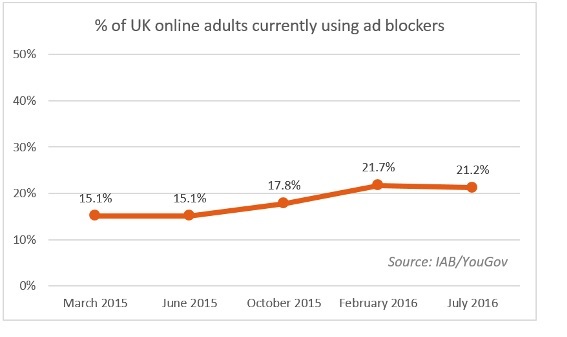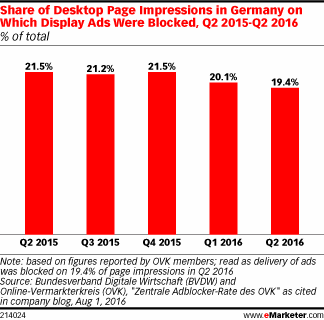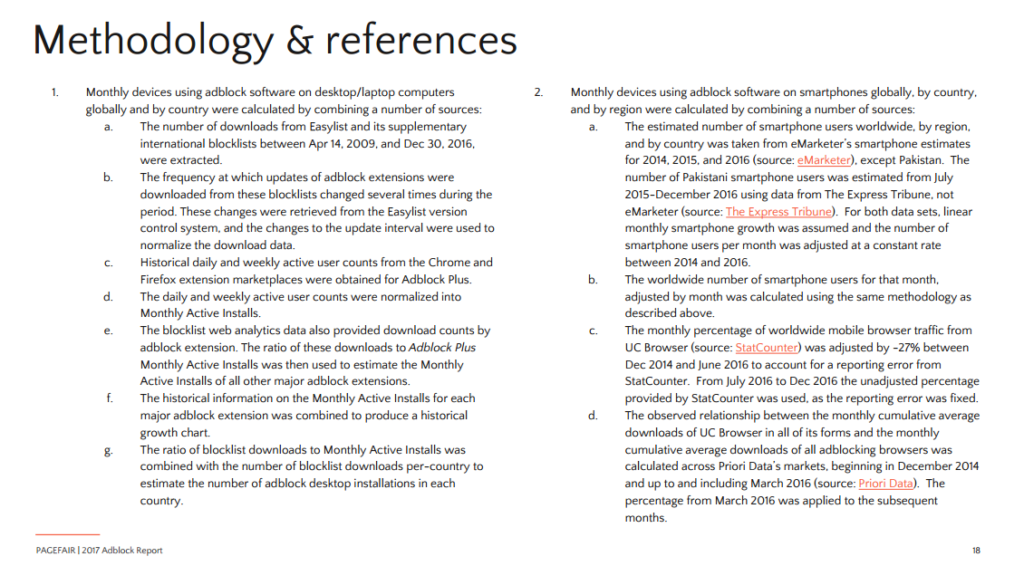Is ad blocking growing faster than we think?

Remember a few months ago when ad execs were publicly hoping the threat of adblockers might not be as bad as we thought? There were theories that ad-blocking might be “self limiting” and may naturally slow on it’s own.
As it turns out, that was wishful thinking.
Last year’s ad blocking “plateau”
Just last August, the IAB reported that use of adblockers had potentially peaked. That forecast was issued on the back of a single quarterly decline in the UK, which showed a drop from 21.7% to 21.2% reported adblock use.
While the decline wasn’t significant enough to constitute a “reversal”, it was enough to raise a few hopes that adblocking just might have plateaued.

That same month, statistics out of Germany’s Online-Vermarkterkreis (OVK) were even more promising. They showed a consistent decline over two quarters from a peak of 21.5% to 19.4% at the end of Q2 2016.

The “plateau” didn’t last. Growth continues…
It’s now six months later and the fresh data is in: PageFair’s excellent 2017 Adblock Report shows that despite a slowdown in plug-in installs, growth resumed in the second half of 2016.
PageFair estimates that by the end of 2016 there were a total of 50 million active desktop adblock installs. That makes for nearly 100% growth in just two years.
Overall desktop web-traffic continues to decline in the US as the shift to mobile continues. Despite that decline in overall desktop traffic, the number of desktop adblock installs continues to rise.
If there’s a bright note anywhere in PageFair’s data, it’s that growth in active desktop adblock installs does appear to be slowing.

But is the problem worse than we think?
As good as PageFair’s report is, there may be reason to believe their data underestimates install growth:
For those who have read my previous posts on this issue, I continue to have questions about PageFair’s statistical methodology. PageFair’s desktop ad-blocking estimates are centered on EasyList filter downloads. However, EasyList itself is often forked and mirrored. As EasyList becomes less universal among ad-blocking plugins, EasyList’s analytics data may be a correspondingly less accurate metric for overall ad blocker installs.

While the methodology does attempt to account for plugins other than Adblock Plus, it’s still dependent on EasyList’s analytics data. Any ad blockers using a separate fork of EasyList’s data would seemingly go uncounted.
Case in point: The AdGuard ad-blocking plugin has been installed nearly 18 million times. But AdGuard’s filter-list is a separately served fork of EasyList. There are other similar examples. I maintain that what may appear to be slowing desktop installs may be partially due to a migration of users to other such “non-EasyList” plugins. Or a migration to plugins which don’t download EasyList from the same source.
Is PageFair’s supposedly slowing rate of adblock-plugin install growth really just illustrating a slow migration away from centralized EasyList downloads?
Aside from consulting a trusty Magic 8 Ball, there’s no way to know.
The upshot
Even if PageFair’s data is correct about the slowing rate of growth, ad blocking clearly continued to become a bigger problem by the end of 2016.
In 2017, publishers will continue to seek more advanced technological solutions to confront ad-blockers. As such, 2017 is already shaping up to be the year of “ad recovery” and “ad replacement“.
2016’s strategy of “blocking adblockers” is giving way to an exciting class of next-gen solutions. Adblock circumvention solutions like ReviveAds are successfully pushing ads past adblockers and upping the ante in what is becoming the Internet’s biggest arms race.
Stay tuned for an upcoming post on the ad reinsertion battleground and how advertisers and publishers are beginning to circumvent adblockers entirely.
Get your popcorn. This fight is just getting started.

Also, AdBlock can’t get detected by lots of scripts that are supposed to detect it. So even when sites try to measure their AdBlock % they probably underestimate it.
If I start to see anybody “pushing ads past adblockers” I will never visit that site again. They have NO RIGHT to bypass MY adblocker. My computer my rules!
Fair enough, but my website, my rules also.
Revenue is what makes websites work. Even people who don’t care to make money from their site have to fund it with money they get from somewhere. Hopefully money they earned in a productive way, and not from the excessive government confiscation of other peoples money.
For many people their site is not only a service they supply to the web community, but also their livelihood.
Granted some ads are too aggressive and I’m against those! But, the online economy has to work in order to continue in the best ways and purposes.
Any ad serving solution that A. relies on non-free software, B. relies on tracking users from one site to another, or C. serves video ads on primarily textual articles, is “too aggressive”.
Thankfully the internet is a user driven ‘pull’ type service that enables 100% user choice.
All modern browsers are equipped with a pop-up blocker as standard kit. Why is that?
Think about this advertisers/publishers.
It may make you feel better to think of it as a “pull”. But it isn’t.
An http request is of course, a “request”. Your browser “requests” a service of a second-party, private server.
You do not have any rights to access that private server other than the rights and permissions granted to you by the server owner.
I have seen a lot of network level ad blocking applications been employed. Personally I install Pi-holes everywhere I can. These then represent tens if not hundreds of users who are protected from ads.
With all the new technologies to fight the ad revenue scam, the true number of people protected from this dilapidating racket is much higher than aggregated numbers show.
If a page blocks my adblock or dare to bypass it, then i use an “anti-anti adblock script” if it does not work, then i proceed to block the entire site and use any alternative i can find, i would never accept being flooded by ads loaded with porn, crappy browser games, gambling sites, or even expose myself to malware in order to see any content ¯_(ツ)_/¯